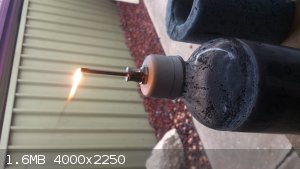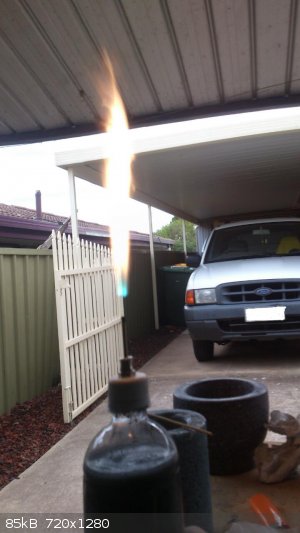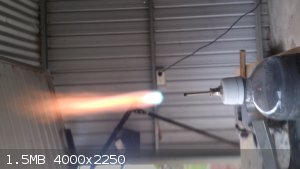| Pages:
1
2 |
metalresearcher
National Hazard
   
Posts: 790
Registered: 7-9-2010
Member Is Offline
Mood: Reactive
|
|
Synthesis of calcium carbide with electric arc
I made CaC2 by arcing lime powder (CaO) and BBQ charcoal and let it react with water. That released acetylene gas with bright flames. So it is rather
easy to make carbide when you have a simple electrode welder and carbon rods.
<iframe sandbox width="640" height="360" src="//www.youtube.com/embed/g_sYaBD__YQ?list=UUJArDPDoXa4a1vzvNqvbu1A" frameborder="0"
allowfullscreen></iframe>
|
|
|
elementcollector1
International Hazard
    
Posts: 2689
Registered: 28-12-2011
Location: The Known Universe
Member Is Offline
Mood: Molten
|
|
For an additional mad science component, check this out: http://mad-science.wonderhowto.com/how-to/turn-microwave-ove...
Warning: High voltage, high temperature.
How good do the carbon rods have to be? I would assume welding grade.
Elements Collected:52/87
Latest Acquired: Cl
Next in Line: Nd
|
|
|
bfesser
Resident Wikipedian
    
Posts: 2114
Registered: 29-1-2008
Member Is Offline
Mood: No Mood
|
|
No references, no analysis. This belongs in Beginnings. I see no evidence that you've produced CaC<sub>2</sub>. The
sparks could just as well be explained by ignition of H<sub>2</sub> gas (from the reaction of Ca<sup>0</sup> with water) mixed
with atmospheric oxygen and the excitation/black-body radiation of various metallic and non-metallic impurities (aerosol). I also don't approve of
the assumption that you've achieved 2000 °C.
|
|
|
bfesser
|
Thread Moved
24-11-2013 at 11:47 |
bismuthate
National Hazard
   
Posts: 803
Registered: 28-9-2013
Location: the island of stability
Member Is Offline
Mood: self reacting
|
|
Well it's relativly easy to analyze it. Just mix it with water and test for acetylene.
Try this experiment. It will clearly indicate that you have acetylene.
http://www.youtube.com/watch?v=YtTnYCZJw94
[Edited on 24-11-2013 by bismuthate]
|
|
|
metalresearcher
National Hazard
   
Posts: 790
Registered: 7-9-2010
Member Is Offline
Mood: Reactive
|
|
View the video from 04:50 and then you see small bright flames when the burner is on the water.
Later I updated this part of the movie with a better C2H2 ignition above the water.
See on
http://www.metallab.net/arcmelt.php?d=#videos
and click on 'Play' (on YT it is not possible to update a video).
|
|
|
bismuthate
National Hazard
   
Posts: 803
Registered: 28-9-2013
Location: the island of stability
Member Is Offline
Mood: self reacting
|
|
I don't believe that this is the best way to analyze something because many gases can burn in the same way.
|
|
|
woelen
Super Administrator
        
Posts: 8079
Registered: 20-8-2005
Location: Netherlands
Member Is Offline
Mood: interested
|
|
Quote: Originally posted by bfesser  | | No references, no analysis. This belongs in Beginnings. I see no evidence that you've produced CaC<sub>2</sub>. The
sparks could just as well be explained by ignition of H<sub>2</sub> gas (from the reaction of Ca<sup>0</sup> with water) mixed
with atmospheric oxygen and the excitation/black-body radiation of various metallic and non-metallic impurities (aerosol). I also don't approve of
the assumption that you've achieved 2000 °C. |
Again, I disagree moving this around. Please stop that
endless moving around of threads! This is an attempt at making CaC2 from easy to obtain materials and I see that the process still is far from
perfect, but with your remarks and attitude you stifle any enthusiasm right from the start. It is this kind of experiments, which can be a first step
to a good working method, by gradual improvements, suggested by other members and supported by further experiments by the OP. Please give constructive
comments. How can this process be improved? Do you have any ideas about that? If so, please post them over here! Simply dismissing everything because
it has no references and so on is counterproductive and soon will lead to the end of enthusiasm and kills the thread and discussion!
|
|
|
bfesser
Resident Wikipedian
    
Posts: 2114
Registered: 29-1-2008
Member Is Offline
Mood: No Mood
|
|
bismuthate, must you turn everything into an explosive? Why not do a simple redox?
metalresearchethr, the sooty flame is readily apparent in this second video, but not in the first. (It is possible to
<em>replace</em> a video; delete and re-upload.)
woelen; I mean no disrespect, but <em>please get off my back</em>. I <em>did</em> provide constructive
criticism in pointing out that he should provide a reference for the process (which he claimed to be based on industry), and in proposing an alternate
explanation for his (lack of) observations. Also, I don't mean to derail this thread by discussing this here; but there's no problem with moving
topics if users are aware of the <img src="./images/xpblue/top_todaysposts.gif" /> <a href="today.php">Today's Posts</a> and <img
src="./images/xpblue/top_search.gif" /> <a href="search.php">Search</a> features (if those aren't enough, use <a
href="memcp.php?action=favorites">Favorites</a> and <a href="memcp.php?action=subscriptions">subscriptions</a> . Perhaps posters should put more careful consideration into their posts before just
slamming something half-assed up wherever their cursor lands. . Perhaps posters should put more careful consideration into their posts before just
slamming something half-assed up wherever their cursor lands.
[Edited on 25.11.13 by bfesser]
|
|
|
bismuthate
National Hazard
   
Posts: 803
Registered: 28-9-2013
Location: the island of stability
Member Is Offline
Mood: self reacting
|
|
Well, it's fun
Jokes aside how do you suggest he test it. That was the best way I know.
|
|
|
woelen
Super Administrator
        
Posts: 8079
Registered: 20-8-2005
Location: Netherlands
Member Is Offline
Mood: interested
|
|
I think that indeed the test with the flame was quite good. What else could cause such flames? Of course, it is not a rigid proof, but it is a first
step in the right direction.
Commercial CaCl2 produces much more C2H2 per unit weight of material, so the process needs improvement, but it is interesting to see that in principle
this can be done in an amateur setting.
|
|
|
bismuthate
National Hazard
   
Posts: 803
Registered: 28-9-2013
Location: the island of stability
Member Is Offline
Mood: self reacting
|
|
It was very nice however I only said it was not the best. It truly is actualy a nice test, only it's not definitive.
|
|
|
watson.fawkes
International Hazard
    
Posts: 2793
Registered: 16-8-2008
Member Is Offline
Mood: No Mood
|
|
Quote: Originally posted by bfesser  | Also, I don't mean to derail this thread by discussing this here; but there's no problem with moving topics if users are aware of the <img
src="./images/xpblue/top_todaysposts.gif" /> <a href="today.php">Today's Posts</a> and <img src="./images/xpblue/top_search.gif"
/> <a href="search.php">Search</a> features (if those aren't enough, use <a href="memcp.php?action=favorites">Favorites</a>
and <a href="memcp.php?action=subscriptions">subscriptions</a> . .
|
If you didn't mean to derail it, you could have easily move a discussion with another moderator, about a
moderation policy, to the Moderator's Lounge, which I take it you are aware of. Quote: Originally posted by bfesser  | Perhaps posters should put more careful consideration into their posts before just slamming something half-assed up wherever their cursor lands.
|
Yes. Yes, they should.
|
|
|
vulture
Forum Gatekeeper
    
Posts: 3330
Registered: 25-5-2002
Location: France
Member Is Offline
Mood: No Mood
|
|
Making copper acetylide is indeed a good test for acetylene. The question is how to safely dispose of the acetylide.
The formation of CaC2 in electric arc furnaces is so well established that I think we can do without references here.
I'd guess an electric arc easily reaches 2000C, if not more.
One shouldn't accept or resort to the mutilation of science to appease the mentally impaired.
|
|
|
metalresearcher
National Hazard
   
Posts: 790
Registered: 7-9-2010
Member Is Offline
Mood: Reactive
|
|
Woelen is right. Indeed commercial CaC2 releases much more gas when contacted with water. I think lots of CaO vaporizes and lots of unreacted CaO +
carbon mixes with the CaC2. Moreover, silicates from the crucible (hole in a concrete brick) can also contaminate the melt. Overheating can also
be an issue as I read in the literature, then it decomposes. The arc itself reaches easily over 3000 C but very locally. As I can see so far, the CaC2
is formed in the liquid state.
[Edited on 2013-11-25 by metalresearcher]
|
|
|
bfesser
Resident Wikipedian
    
Posts: 2114
Registered: 29-1-2008
Member Is Offline
Mood: No Mood
|
|
You mean <em>only</em>?
You might try studying basic General and Organic Chemistry sometime, in addition to Energetic Materials; you might just find something else which
peaks your interest—if not, at least you'll learn something. Studying one area of interest in great detail is admirable, but it couldn't
hurt to "expand your horizons."
<a href="http://en.wikipedia.org/wiki/Alkyne#Reactions" target="_blank">Alkyne: Reactions</a> <img src="../scipics/_wiki.png" />
Facile tests for ethyne (unsaturation) <em>which don't involve preparing explosives</em>:<ul><li>decolorization of very dilute
KMnO</sub>4</sub>(aq)</li><li>decolorization of <a href="http://en.wikipedia.org/wiki/Bromine_water"
target="_blank">bromine water</a> <img src="../scipics/_wiki.png" /></li><li>spontaneous reaction <a
href="https://www.flinnsci.com/media/620548/91234.pdf" target="_blank">with chlorine</a> <img src="../scipics/_pdf.png"
/></li></ul> Attachment: ethyne.doc (39kB)
This file has been downloaded 2378 times
[Edited on 25.11.13 by bfesser]
|
|
|
vulture
Forum Gatekeeper
    
Posts: 3330
Registered: 25-5-2002
Location: France
Member Is Offline
Mood: No Mood
|
|
Given the possible hydrogen content I would caution against the chlorine test.
One shouldn't accept or resort to the mutilation of science to appease the mentally impaired.
|
|
|
metalresearcher
National Hazard
   
Posts: 790
Registered: 7-9-2010
Member Is Offline
Mood: Reactive
|
|
Well here I did a test of the chunks into water and got a nice acetylene flame !
<iframe sandbox width="640" height="360" src="//www.youtube.com/embed/zL5ZNIzKF30" frameborder="0" allowfullscreen></iframe>
|
|
|
bfesser
Resident Wikipedian
    
Posts: 2114
Registered: 29-1-2008
Member Is Offline
Mood: No Mood
|
|
Very nice. Although it's generally considered poor practice (unsafe) to set fire to a jet on a container of flammable gas like that before you're
100% certain that oxygen has been displaced from within. With a plastic bottle, however, the risk is greatly reduced; but please be careful with your
experiments. Do you plan to continue work toward improving this process?
[Returned to Technochemistry. Sorry, I shouldn't have moved it to begin with.]
[Edited on 30.11.13 by bfesser]
|
|
|
bfesser
|
Thread Moved
30-11-2013 at 10:58 |
metalresearcher
National Hazard
   
Posts: 790
Registered: 7-9-2010
Member Is Offline
Mood: Reactive
|
|
@bfesser: Yes, I try to improve the process.
The lime I used turned out to be slaked lime Ca(OH)2. That did work but now I heated the Ca(OH)2 to 600 C to convert it to CaO and when I use that the
yield of CaC2 is better. Now I fill a container with crushed charcoal, put two carbon rods into it 1-2cm apart, put some CaO powder on it and let it
slowly start and run for 1-2 minutes. The charcoal itself acts al electrodes and resistance heating.
Then I let it cool and the harder chunks within are (impure) CaC2 which fizzle strongly with water.
|
|
|
BobD1001
Hazard to Others
  
Posts: 182
Registered: 29-3-2013
Member Is Offline
Mood: No Mood
|
|
Great work! Very cool to see someone successfully synthesize calcium carbide in the home lab setting!
|
|
|
IrC
International Hazard
    
Posts: 2710
Registered: 7-3-2005
Location: Eureka
Member Is Offline
Mood: Discovering
|
|
While chemistry is not my area of study I have learned enough to wonder about the possibility of CaCN also being a byproduct since in an amateur home
setting likely this experiment will be exposed to N2 in the air unless this was conducted in a controlled atmosphere. I bring it up since I believe it
should be considered by beginners in the field doing this at home. The last thing one should be doing is cavalierly handling products which may
contain cyanide they are completely unaware of. Or am I just being overly paranoid here?
"Science is the belief in the ignorance of the experts" Richard Feynman
|
|
|
smaerd
International Hazard
    
Posts: 1262
Registered: 23-1-2010
Member Is Offline
Mood: hmm...
|
|
Very cool as always MetalResearcher.
Out of curiosity how are you moving the electrodes safely?
|
|
|
NedsHead
Hazard to Others
  
Posts: 409
Registered: 9-12-2014
Location: South Australia
Member Is Offline
Mood: No Mood
|
|
I dusted off my welder, bought a bag of lime and gave this synthesis a go today, the first few attempts didn't yield much calcium carbide, I think I
was decomposing the CaC2 through overheating.
Once I got my temperature somewhat under control I had great success, the chunks of calcium carbide synthesized reacted strongly when dropped into a
glass of water, so strong that once lit the flame was self sustaining. An Impressive success!!
|
|
|
ave369
Eastern European Lady of Mad Science
   
Posts: 596
Registered: 8-7-2015
Location: No Location
Member Is Offline
Mood: No Mood
|
|
Is this method suitable for synthesis of other carbides, such as Al4C3 and Mg2C3?
|
|
|
NedsHead
Hazard to Others
  
Posts: 409
Registered: 9-12-2014
Location: South Australia
Member Is Offline
Mood: No Mood
|
|
Below are some pics of today's results, still pretty good but I haven't been able to reproduce the excellent results I had last week. That'll teach me
for not taking notes


[Edited on 16-7-2015 by NedsHead]

|
|
|
| Pages:
1
2 |